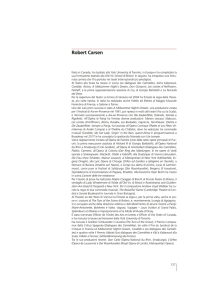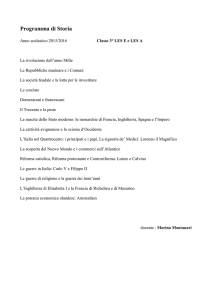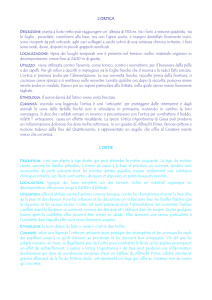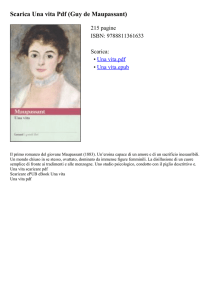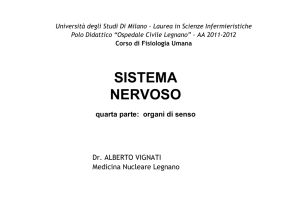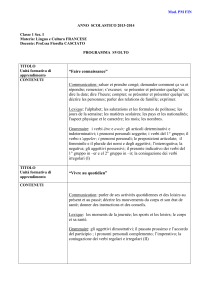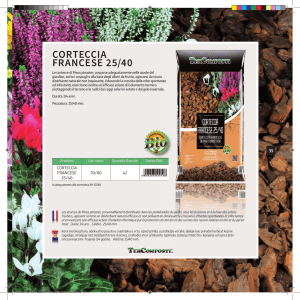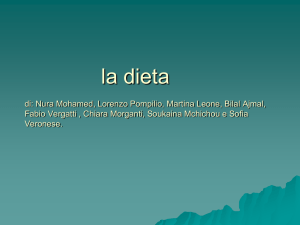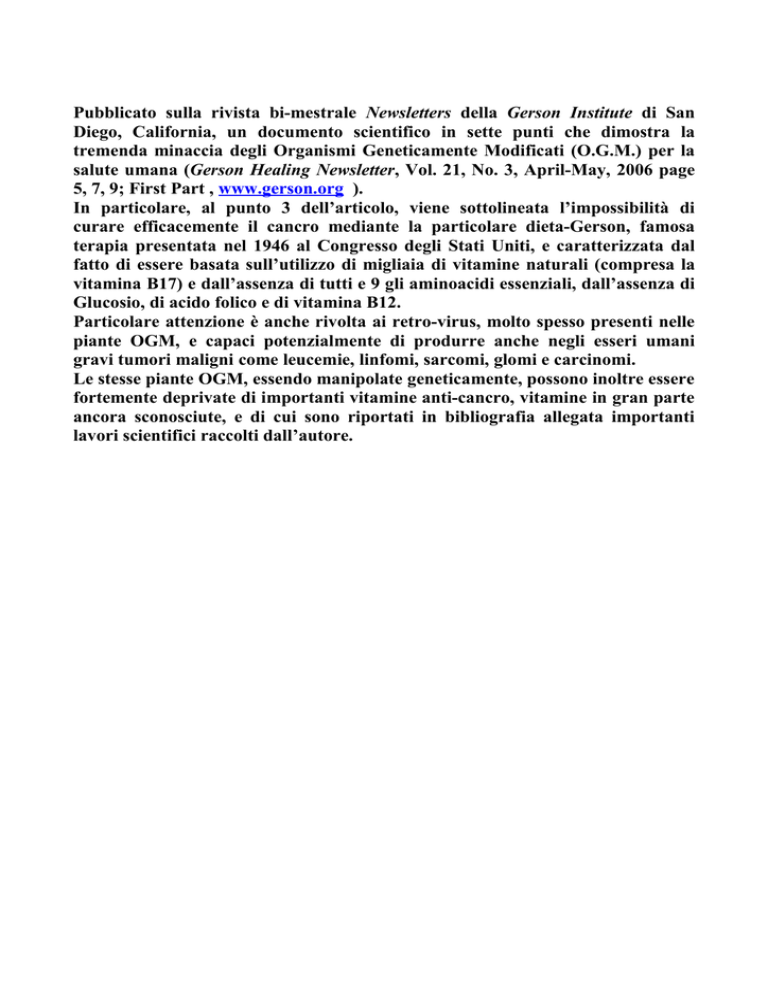
Pubblicato sulla rivista bi-mestrale Newsletters della Gerson Institute di San
Diego, California, un documento scientifico in sette punti che dimostra la
tremenda minaccia degli Organismi Geneticamente Modificati (O.G.M.) per la
salute umana (Gerson Healing Newsletter, Vol. 21, No. 3, April-May, 2006 page
5, 7, 9; First Part , www.gerson.org ).
In particolare, al punto 3 dell’articolo, viene sottolineata l’impossibilità di
curare efficacemente il cancro mediante la particolare dieta-Gerson, famosa
terapia presentata nel 1946 al Congresso degli Stati Uniti, e caratterizzata dal
fatto di essere basata sull’utilizzo di migliaia di vitamine naturali (compresa la
vitamina B17) e dall’assenza di tutti e 9 gli aminoacidi essenziali, dall’assenza di
Glucosio, di acido folico e di vitamina B12.
Particolare attenzione è anche rivolta ai retro-virus, molto spesso presenti nelle
piante OGM, e capaci potenzialmente di produrre anche negli esseri umani
gravi tumori maligni come leucemie, linfomi, sarcomi, glomi e carcinomi.
Le stesse piante OGM, essendo manipolate geneticamente, possono inoltre essere
fortemente deprivate di importanti vitamine anti-cancro, vitamine in gran parte
ancora sconosciute, e di cui sono riportati in bibliografia allegata importanti
lavori scientifici raccolti dall’autore.
La minaccia degli Organismi Geneticamente Modificati (OGM)
Le vitamine e le sostanze pro-vitaminiche presenti nelle piante naturali di comune alimentazione
umana possono essere stimate in numero superiore a 15.000-30.000 tipi. L’introduzione
nell’agricoltura moderna degli Organismi Geneticamente Modificati (O.G.M.) è una ingiustificata e
pericolosissima alterazione di ciò che l’Evoluzione ha prodotto nelle piante in centinaia di milioni
di anni: piante sulle quali si è basata la successiva evoluzione biochimica dei complessi organismi
animali superiori, culminati con l’avvento dei Mammiferi negli ultimi 65 milioni di anni e quindi
con la comparsa dell’Uomo; pertanto il delicato equilibrio biochimico della specie umana dipende
dall’integrità delle specie vegetali così come l’Evoluzione le ha condotte fino a noi, poiché la Salute
di ciascuno di noi è basata sulla Biochimica cellulare umana, e questa dipende, nella propria
complessità genomica (DNA), dall’utilizzo di migliaia di vitamine e di complessi fitochimici
presenti in Natura.
La personale visione dell’autore del presente lavoro che, come medico nucleare, ha avuto modo di
studiare per anni gli effetti delle radiazioni ionizzanti su organismi complessi, è che la pianta è
anch’essa un organismo complesso, frutto dell’evoluzione biologica avvenuta in centinaia di milioni
di anni: ogni modificazione genetica provocata in essa dall’Uomo (con radiazioni come a
Chernobyl, o con virus come attualmente compiuto con gli OGM), per quanto minima possa essere
tale modificazione, essa produrrà comunque un danno, un danno irreparabile che spesso non potrà
essere riconosciuto, poiché l’Uomo conosce con sicurezza soltanto poche decine di vitamine e di
altre sostanze pro-vitaminiche. Viceversa, le vitamine e le altre sostanze contenute nelle piante sono
decine di migliaia, e sono queste le responsabili del corretto funzionamento della complessa
biochimica umana e del genoma umano (DNA).
Ma oggi, per ottenere il vantaggio di una maggiore produzione agricola, si ricorre al metodo di
modificare il patrimonio genetico delle piante naturali, allo scopo di modificarne la struttura,
renderle sterili (piante “TERMINATOR”) per obbligare gli agricoltori a comprare nuovi semi ogni
anno), brevettarne la trasformazione indotta, e rivendere in tutto il mondo il prodotto così ottenuto.
Si afferma inoltre che esista sostanziale equivalenza tra il prodotto geneticamente modificato
(OGM) e quello ottenuto con la selezione dei caratteri genetici (cioè tramite incrocio naturale di
piante come da sempre fatto dall’umanità nel corso di migliaia di anni). Da parte dell’autore del
presente lavoro, si afferma invece che tale “sostanziale equivalenza” è assolutamente insostenibile,
perché l’incrocio naturale di piante avviene con semi naturali della stessa specie, mentre la
manipolazione genetica (OGM) avviene superando le barriere di specie vegetali, mediante
introduzione di geni di altre specie vegetali, o addirittura di batteri, virus o animali. Infatti la
maggior parte dei geni usati dall’ingegneria genetica provengono da specie viventi che non hanno
mai fatto parte dell’alimentazione umana e, addirittura, sono provenienti da DNA non appartenenti
a piante ma ad animali, batteri o virus e/o retrovirus transgenici.
Si possono così ravvisare SETTE minacce immediate:
PRIMO: Depauperazione dei complessi pro-vitaminici e vitaminici delle piante.
Depauperazione di complessi vitaminici e pro-vitaminici non più presenti negli alimenti, con conseguente incremento
delle malattie degenerative e carenziali come ad esempio il Cancro. Gravissimo è, ad esempio, il deliberato tentativo di
disattivare (con Fortilin, Bcl-2, Bcl-xl) le sostanze naturali contenute nelle piante, cioè quelle vitamine che entrano in
complessi meccanismi enzimatici nel DNA dei mammiferi, e inducenti il fenomeno di apoptosi (suicidio) in queste
cellule di mammifero se ammalate da cause infettive o di altro genere (come ad esempio il Cancro). Tale fenomeno di
blocco dell’apoptosi (azione di anti-apoptosi), introdotto sperimentalmente nella pianta del tabacco tramite virus (748,751,
1254
) è un gravissimo atto di danno deliberato inflitto all’Ecosistema tramite gli O.G.M.: un danno che, se propagato a
piante alimentari di uso comune, potrebbe rendere del tutto impossibile la cura dei tumori e di molte altre malattie
tramite quanto considerato in questo lavoro.
Gravissima è anche la possibile scomparsa di molte vitamine naturali anti-cancro (Antocianine, Flavonoidi (1122),
Polifenoli (1123), sesquiterpene lattone Partenolide (701), penta-acetil Geniposide (1061), Camellina B (698), betaCriptoxantina (1063), Esperidina (1063), Emodina (247,333,715), acido ursolico (700), Solfuro di allile (694,696), Eriodictoiolo (693),
protocatechine (692), Indoli (809), Isotiocianati (809), Resverarolo (695), Elemene (690), Acutiaporberina (711), Capsaicina
(719), Wagonina (713), Fisetina (713), acido carnosico (712,1062), Germanio sesquiossido (269), Epigallocatechina gallato
(173,1124), Limonene (693), Axeroftolo palpitato, alfa e beta Carotene, acido trans-Retinoico, Tocoferoli, Cinaropicrina,
Licopene (633), Proantocianidina, Damnacanthal (1043), Baicalina (718), Baicaleina (718), acido idrocinnamico (693),
sesquiterpenoidi come Atractilone (704), come Atractilenolidi I, II, III (704), alcaloidi del Gelsemio (699), altri flavonoidi
(1064), Sinigrina, acido ferulico, acido ellagico, acido cumarinico …) inducenti l’apoptosi (suicidio) dei tumori.
Questa scomparsa può avvenire a causa della modificazione OGM di piante ad uso alimentare o medico: sono riportate
molte vitamine e molte piante che inducono questo fenomeno di suicidio del cancro, con aggiunta dei dati di
bibliografia scientifica su diverse modifiche apportate dalle Multinazionali OGM.
Ad esempio: Pueraria species induce apoptosi sul neuroblastoma (1046) ma, il contenuto di Antocianine (apoptosi su
tumori) della Pueraria-OGM è gravemente decresciuta al 40% (1119).
Gravissima, è poi l’assenza dei semi dai frutti OGM: l’importanza dei semi come fattori anti-cancro risiede
sostanzialmente nel fatto che essi contengono la famosa vitamina B17, ma è estremamente grave il fatto che le grandi
aziende semeniere OGM stiano immettendo sul mercato agricolo mondiale gli stessi frutti privi però di semi, in
particolare: Cucumis melo, Citrus limonum, Citrullus vulgaris, Solanum lycopersicum, Vitis vinifera….
SECONDO: mutazioni genetiche delle piante e conseguente alterazione della Biochimica umana
A causa dell’introduzione di geni estranei (es. di animali, batteri, virus, retrovirus) nel DNA della pianta, si verifica in
essa l’alterazione della normale sequenza genomica, con la comparsa di nuove proteine e/o la perdita di altre proteine di
sequenza genomica. Di qui la comparsa di nuove sostanze simili alle vitamine naturali, ma in realtà con caratteristiche
di reattività enzimatica e biochimica diverse da quelle naturali, con induzione pertanto di modifica della loro
componente di attività biochimica sul genoma umano, una volta introdotte con l’alimentazione.
Di qui la comparsa potenziale di nuove malattie insorte “artificialmente” a causa di manipolazione genetica (OGM) di
organismi vegetali, inquinati geneticamente da nuove molecole simil-vitaminiche dagli effetti induttivi sul DNA umano
e sulla sua complessa biochimica del tutto sconosciuta, ma probabilmente foriera di gravi danni data l’estrema
complessità e quindi vulnerabilità del DNA umano.
TERZO: la minaccia alla dieta-anti-cancro
Come già dimostrato da diversi Autori (749,750), solo un’alimentazione basata su frutta e verdura fresca biologica è in
grado di indurre risposta immunitaria contro il tumore, la detossificazione degli organi e dei tessuti, e il particolare
fenomeno dell’apoptosi (suicidio) delle cellule malate. La chiave di spiegazione di tale efficacia curativa di queste
particolari diete vegetariane risiede nel fatto di non assimilare mai cibi contenenti tutti i potenziali fattori di crescita
cellulare, in particolare l’assimilazione contemporanea di tutti e 9 gli aminoacidi essenziali (Valina, Isoleucina,
Leucina, Lisina, Metionina, Istidina, Triptofano, Fenilalanina, Treonina [Arginina nel bambino]), degli acidi nucleici
(DNA, RNA), della vitamina B12, dell’acido folico e, relativamente, anche acido para-aminobenzoico [PABA]): una
volta, i cibi che contenevano tutto ciò erano unicamente i cibi di origine animale (carne, pesce, uova, latte, formaggio,
burro..) che sia Gerson che altri Autori (compresa anche la medicina cinese e indiana) proibivano di assumere per
almeno 1 anno. In particolare risultava così vincente la sola alimentazione vegetariana, cioè a base di sola frutta e di
verdura, compresi i cereali e i legumi. Questi ultimi cibi sono ricchi di proteine, e ciò può stupire che venissero
comunque impiegati nella terapia del Cancro da Gerson e da molte altre scuole di medicina naturale occidentale,
indiana e cinese. Ma il motivo del loro uso riposava sul fatto che nessun cereale e nessun legume conteneva da solo tutti
e 9 gli aminoacidi essenziali. Questi alimenti però, se uniti insieme nello stesso pasto, determinavano l’assimilazione di
tutti e 9 gli aminoacidi: di qui il divieto assoluto di non mangiare assieme Pasta (o Polenta, o Pane [anche se azimo] o
Riso) con Legumi, poiché si avrebbe avuto integrazione dei nove aminoacidi essenziali (8 contenuti nei cereali + 8
contenuti nei legumi), con effetto nutrizionale simile a quello ottenuto dalla Carne (in fondo, una volta, un piatto di
Pasta e fagioli era anche chiamato ….la carne dei poveri….)
Oggi però, tramite l’introduzione in commercio di cereali, legumi e altri vegetali modificati geneticamente (O.G.M.) in
molti di questi alimenti sono contenuti TUTTI gli aminoacidi essenziali (1065), rendendo in tal modo effettivamente
NON più curabile il Cancro secondo quanto descritto in questo lavoro, nella terapia Gerson, e da molti altri autori.
QUARTO : malattie indotte da virus transgenici
I virus transgenici con cui oggi si fanno gli Organismi Geneticamente Modificati (O.G.M.) entrano nel DNA della
pianta, modificandola in maniera a noi sconosciuta. Questi virus dovrebbero restare latenti, ma nulla può escludere che
possano anche riattivarsi in maniera analoga ai ben noti virus tumorali a RNA (Oncornavirus) o come i virus tumorali a
DNA (entrambi induttori di leucemie, sarcomi, carcinomi, gliomi…). Questi virus possono anche essere portatori di
malattie nuove o di malattie abbastanza simili a ben note sindromi purtroppo ancora poco comprese nella loro dinamica
(AIDS, Mucca Pazza, etc…), e di cui è ancora molto vaga l’origine (forse virus trangenici ).
In merito a virus impiegati per costruire O.G.M. vi è un’ampia bibliografia (738-747,1120).
Si ritiene necessaria la ricerca in pazienti malati di tumore della possibile genesi del tumore da retro-virus introdotti con
l’alimentazione.
Tutto ciò richiede però l’accesso ad informazioni riservate, forse coperte da brevetto, in merito ai modelli di retrovirus
impiegati dalle multinazionali OGM, e alle modifiche apportate loro dalle stesse aziende prima della immissione in
commercio delle stesse piante OGM.
E’ difficile rintracciare virus tumorigeni a DNA impiegati dalle multinazionali OGM per modificare il DNA delle
piante ad uso alimentare, poiché questi virus (Pox-virus, Herpes-virus, Papova-virus, Adeno-virus), a differenza degli
Oncorna-virus, non sono rilevabili nel siero, nelle urine del paziente o nel tumore stesso. E’ però dimostrato che nel
citoplasma di cellule tumorali di mammifero infettate e modificate da questi virus a DNA permane una piccola frazione,
altamente specifica, di RNA messaggero, che non si trova né in cellule normali, né in cellule tumorali infettate da altri
tipi di virus oncogenici a DNA. Un’ibridazione positiva, rivelata dalla formazione di DNA ibrido radioattivo (32P)
indica la presenza si sequenze di DNA virale nelle cellule trasformate (1280)
QUINTO : intossicazione da veleni sintetizzati da piante transgeniche
Intossicazione cronica di cibi a causa di sostanze tossiche insetticide contenute nelle piante per renderle resistenti ai
parassiti come il Bacillus touringiensis (789-793), con conseguente possibile incremento di cancri, aborti spontanei,
mutazioni genetiche sulla discendenza, Sindromi da Immunodeficienze acquisite, malattie degenerative e da sostanze
tossiche, etc….
SESTO: modificazione transgenica di piante naturali
Passaggio a specie “indigene” naturali delle sostanze tossiche artificiali, come ad esempio il “Bacillus thuringiensis”(789793
) o di altro tipo, tramite impollinazione incrociata, con potenziale minaccia anche per le piante e le erbe mediche oggi
impiegate in Fito-Terapia poiché queste ultime saranno inquinate dai geni transgenici provenienti dalle zone agricole a
coltura transgenica (OGM).
SETTIMO: scomparsa irreversibile del patrimonio genetico delle piante naturali
Graduale ed irreversibile scomparsa delle diversità biologiche, cioè della normale flora naturale. Le coltivazioni
transgeniche arrecheranno infatti una gravissima minaccia alle zone ricche di bio-diversità (genomi naturali): il flusso
transgenico che andrà dalle piante modificate alle piante naturali sarà inevitabile quando il rapporto numerico fra aree
coltivate con piante artificiali supererà le superfici delle piante naturali, determinando così la perdita irreversibile di
gran parte del patrimonio genetico naturale di tutte le piante esistenti al mondo, attualmente pari a circa 442.000 specie
già classificate, su un totale stimato di circa 600.000-800.000 specie.
In sostanza:
Numerose piante sono già scomparse nel corso di questi ultimi anni perché gli agricoltori hanno
abbandonato le piante naturali, per adottare invece varietà di piante artificiali, cioè geneticamente
modificate, poiché rese uniformi nel proprio genoma, ad alto rendimento di produzione (ma povere
di vitamine), intrinsecamente malate (poiché incapaci di sopravvivere in assenza di pesticidi), rese
sterili per ragioni di mercato, e infine manipolate geneticamente per essere rese resistenti agli insetti
e ad altri animali poiché capaci di produrre esse stesse dei veleni, cioè delle sostanze tossiche che
verranno infine mangiate dagli animali di allevamento e dall’uomo stesso. Persino nelle foreste la
varietà genetica è oggi minacciata dalle perdite di habitat, non solo da pratiche di deforestazione
scorrette, ma persino dalla contaminazione del patrimonio genetico adattatosi a situazioni locali da
parte di ibridi creati dalle grandi ditte sementiere produttrici degli OGM.
I prodotti transgenici rappresentano quindi, proprio per come sono concepiti, una formidabile spinta
per accentuare le caratteristiche di unilateralità delle monocolture, e quindi di scomparsa del
patrimonio genetico naturale esistente da centinaia di milioni di anni. Non avremo quindi più, nel
futuro più o meno prossimo, tutte quelle varietà di piante (alimentari e non) caratteristiche di ogni
particolare regione nazionale o locale. La contaminazione genetica ambientale indotta da parte di
ibridi creati dalle grandi ditte sementiere degli OGM, che inevitabilmente s’incroceranno con le
varietà presenti in natura, porterà ad una perdita del patrimonio genetico naturale (non recuperabile
in alcun modo), di tutte quelle particolari caratteristiche che sono entrate nel genoma delle piante
nel corso dei lunghi processi di adattamento alle varie situazioni ambientali. Tale perdita è oggi
gravissima persino per gli ambienti naturali come le foreste. Sostanzialmente, la base stessa della
Biochimica umana è oggi minacciata nella sua più intima essenza (DNA umano) dall’impiego
sconsiderato di queste piante artificiali, senza alcuna possibilità di recuperare un patrimonio
genetico di oltre 440.000 specie di piante classificate (su un totale 600.000- 800.000 stimate), di cui
una buona parte scompariranno nel giro di poche centinaia di anni, minate alla base dai danni
genetici introdotti dall’Uomo.
La pianta è un organismo complesso, frutto dell’evoluzione biologica avvenuta in centinaia di
milioni di anni. Ogni modificazione genetica provocata in essa dall’Uomo, per quanto minima,
produrrà comunque un danno, un danno irreparabile che spesso non potrà essere riconosciuto,
poiché l’uomo conosce con sicurezza soltanto poche decine di vitamine e di altre sostanze provitaminiche. Viceversa, le vitamine e le altre sostanze contenute nelle piante sono decine di
migliaia, e sono queste le responsabili del corretto funzionamento della complessa biochimica
umana e del genoma umano (DNA).
NOTA: Intanto, la contaminazione genetica potrebbe essere ufficialmente autorizzata in USA: è
stata infatti presentata una proposta in base alla quale il FDA autorizzerebbe la contaminazione
delle colture alimentari in USA, se originata da colture sperimentali. Il fine, a quanto pare, è di
consentire alle industrie o agli Istituti di ricerca di conservare il segreto industriale. Come fa
osservare Adrian Bebb, di Friends of the Earth, questo renderà impossibile la verifica di qualsiasi
alimento importato dagli USA, poiché, come dice “non sarà possibile eseguire alcun test dal
momento che non si potrà sapere per quale sostanza eseguire i test, e sarebbe consentito anche
l’inquinamento originato da piante modificate per produrre medicinali.”
L’FDA è quindi procinto di pubblicare quella che può essere di certo considerata la legge che
legalizzerà la contaminazione degli alimenti con materiale transgenico. La politica recentemente
adottata da tale organo governativo stabilisce linee-guida secondo le quali un’azienda può
volontariamente consultarsi con l’FDA ed ottenere da essa l’approvazione del proprio materiale
transgenico in fase di sperimentazione come “accettabile” nei casi di contaminazione. Tale
procedura fornirà alle aziende la copertura legale nei casi di contaminazione e garantirà loro
l’autorizzazione delle proprie sementi sperimentali che così entreranno subito nella catena
alimentare. Dal momento che più di due terzi degli OGM coltivati in via sperimentale negli USA
contengono geni le cui caratteristiche specifiche sono considerate di natura “confidenziale”, non si
ha attualmente alcuna informazione su di essi. Impossibilitati a venire in possesso di tali essenziali
informazioni, i laboratori di analisi contro l’inquinamento OGM non saranno più in grado di
riscontrarne la presenza nei prodotti alimentari, cosa che ovviamente avrà graviissime ripercussioni
sull’attività di tutte quelle aziende che si adoperano costantemente per prevenire i fenomeni di
contaminazione OGM.
VERSIONE IN LINGUA INGLESE
The Threat of Genetically Modified Organisms
Cancer is a degenerative disease caused by a lack of vitamins and poisoning from chemical
substances present in food. One can estimate the number of vitamins and pro-vitamin substances
present in natural plants commonly used as food by humans, as more than 15,000 – 30,000 types.
The introduction into modern agriculture of Genetically Modified Organisms (GMOs) is an
unjustified and dangerous alteration of what Evolution has produced in plants over hundreds of
millions of years: plants on which the subsequent biochemical evolution of superior complex
animal organisms has been based, culminating with the advent of mammals in the last 65 million
years and then with the arrival of Man. The delicate biochemical balance of the human race depends
on plant species remaining integral, just as evolution created them, because the health of every one
of us is based on the biochemical human cell, and this depends, through the complexity of the
DNA, on the use of thousands of vitamins and of the herbal-chemical compounds present in nature.
GMOs
To get maximum agricultural production today we resort to changing the genetic patrimony of
natural plants, with the aim of changing their structure and making them sterile (thus farmers have
to buy new seeds every year), patenting the transformation induced and re-selling the product all
over the world. It has been stated that there is a substantial equivalence between the genetically
modified product (GMO) and that obtained by selecting genetic characteristics (that is by means of
naturally crossbreeding plants as has been done by man over the course of thousands of years).
However the idea of ‘substantial equivalence’, cannot be supported, because the natural
crossbreeding of plants uses seeds of the same species, while genetic manipulation (GMO) crosses
all barriers, and introduces genes from other types of vegetable species or even bacteria, viruses and
animal genes. In fact the majority of genes used in genetic engineering come from living species
which have never been a part of the human food chain and actually come from the DNA not of
plants but of animals, bacteria or viruses and/or transgenic retroviruses.
As a doctor qualified in nuclear medicine the author has had the opportunity to study the effects of
ionizing radiation on complex organisms for years. It is his personal view that plants, too, are
complex organisms: every genetic modification caused by man (through radiation such as that
emitted at Chernobyl, or viruses such as presently used in GMO), however small that modification
may be, will cause damage, irreparable damage which often cannot be seen, because man has only
discovered a limited number of safe vitamins and pro-vitamin substances. There are, however, tens
of thousands of vitamins and it is these which are responsible for the correct functioning of the
biochemical human complex and the human genome (DNA).
SEVEN immediate threats can be identified:
FIRST: The impoverishment of pro-vitamin complexes and vitamins in plants.
Vitamin and pro-vitamin compounds no longer present in foods, with the consequent increase in degenerative and
deficiency diseases like Cancer. On this subject, recent scientific research has shown that transgenic food causes the
immune defense system in rats to collapse, with the subsequent appearance of tumors.
The deliberate attempt to deactivate the natural substances in plants (with Fortilin, Bcl-2, Bcl-xl) is, for example, very
serious. These are vitamins which enter into the complex enzymatic mechanism of DNA in mammals, inducing the
apoptosis (suicide) phenomenon in these mammal cells if they are diseased though infection or other illnesses (such as
cancer). This action of blocking apoptosis, introduced experimentally into the tobacco plant by means of a virus
(748,751,1254) is a serious act of deliberate damage inflicted on the ecosystem by means of GMO; damage which, if it is
propagated on plants in commonly used food, may make it completely impossible to cure tumors and other diseases by
the methods considered in this study.
See PDF allegated : Ichiro Mitsuhara: Animal cell-death suppressors Bcl-x and Ced-9 inhibit cell death in tobacco
plants, Current Biology, Vol. 9, No. 14, pp.775-778, [05042617202612198.pdf]
It’s heavy the possible disappearance of anti-cancer vitamins, that induce apoptosis (suicide) of the tumors
(Anthocyanin, Flavonoids (1122), Polyphenols (1123), sesquiterpene lactone Parthenolide (701), penta-acetyl Geniposide
(1061), Camelliin B (698), beta-Cryptoxantin (1063), Hesperidin (1063), Emodin (247,333,715), ursolic acid (700), allyl Sulfur
(694,696), Eriodictoyol (693), hibiscus protocatechin acid (692), Indoles (809), Isothiocyanates (809), Resverarol (695), Elemene
(690), Acutiaporberine (711), Capsaicin (719), Wagonin (713), Fisetin (713), carnosic acid (1062), Germanium sesquioxide (269),
epigallocatechin Gallate (173,1124), Axerophthol palmitate, alpha and beta Carotene, trans-Retinoic acid, Tocopherols,
Limonene (693), Cynaropicrin, Lycopene (633), Proanthocyanidin, Damnacanthal (1043), Baicalin (718), Baicalein (718),
hydrocinnamic acid (693), sesquiterpenoids as Atractylon (704), as Atractylenolides I, II, III (704), gelsemium alkaloids
(699), tartary buckwheat flavonoid (1064), Sinigrin, ferulic acid, ellagic acid, cumarinic acid, …)
This disappearance may to happen because of GMO-modification of food-plants and/or medical-plants : are listed many
vitamins and many plants that induced apoptosis (suicide) of cancer. But the Agro-industrial Multinationals (GMO)
have spoiled seriously these natural vitamins. For example: Pueraria species induced apoptosis on human
neuroblastoma cell line SK-N-MC (1046) but, the contents of Antocyanin (apoptosis on toumors) of the GMO-Pueraria
were dramatically decreased by 40% (1119); See PDF allegated: Joung JY.: An overexpression of chalcone reductase of
Pueraria montana var. lobata alters biosynthesis of anthocyanin and 5’-deoxyflavonoids in transgenic tobacco,
Biochem Biophys Res. Commun 2003, 303, pp.: 326-331. [5070316220110631.pdf]
In addition, to the possibile disappearance of anti-cancer vitamins that induce apoptosis (suicide) of tumors there is the
elimination of seeds from GMO fruits. The importance of seeds as anti-cancer factors resides principally in the fact that
they contain vitamin B17.
The big GMO seed companies are putting onto the world agricultural market the same fruits, such as: Cucumis melo,
Citrus limonum, Citrullus vulgaris, Solanum lycopersicum, Vitis vinifera, without seeds to inflict deliberate damage on
the ecosystem.
SECOND: genetic mutation of plants and the subsequent alteration of human biochemistry
Because of the introduction of foreign genes (for example from animals, bacteria, viruses and retroviruses) into the
DNA of plants, an alteration in the normal genomic sequence of the plant occurs, with the appearance of new proteins
and/or the loss of other proteins of a genomic sequence. New substances similar to natural vitamins have appeared, but
which actually have enzymatic and biochemical characteristics different from natural ones, and therefore impose
changes in their biochemical activity on the human genome, once they have been introduced through food.
Hence there is the potential risk of new diseases of an ‘artificial’ type, caused by the manipulation (GMO) of vegetable
organisms, genetically polluted by new vitamin molecules with totally unknown inductive effects on the human DNA,
but given it’s extreme complexity and vulnerability probably heralding serious damage.
THIRD: the threat to the anti-cancer diet
As has already been demonstrated by Gerson (749,750,969) and other authors, many substances contained only in
biologically grown raw fruit and vegetables are able to induce the immune cascade against tumors, bring about
detoxification and the particular phenomenon of apoptosis (suicide) of diseased cells. The explanation of the
effectiveness of these vegetarian diets lies in the fact that patients do not consume food containing all the potential
factors which promote cell growth, in particular they do not simultaneously consume the NINE essential amino acids
(Valin, Isoleucin, Leucin, Lisin, Metionin, Hystidine, Tryphtophan, Phenylalanine, Treonine), nucleic acids (DNA,
RNA), vitamin B12, folic acid and also para-aminobenzoic acid [PABA]. Once the foods which contained all of these
were of animal origin (meat, fish, eggs, milk, cheese, butter…): both Gerson and other authors (including Chinese and
Indian medicine) forbade the consumption of these foods for at least a year. A vegetarian diet, based on fruit and
vegetables and cereals, is , thus, the winning diet. These foods are rich in protein and thus their use in cancer therapy by
Gerson and other Western, Chinese and Indian schools of natural medicine might seem surprising. No cereal and no
vegetable contained by itself the NINE essential amino acids. However, if consumed together at the same meal they
determine the intake of the NINE amino acids. With the introduction on the market and the possible contamination of of
all cereals, pulses and other vegetables which GMOs, many of these foods contain ALL the essential amino acids(1065),
effectively rendering cancer NO LONGER curable by natural therapies like that of Gerson (749,750,969) and many other
authors.
FOURTH: diseases induced by transgenic viruses
The transgenic viruses with which genetically modified organisms (GMO) are treated today enter into the DNA of the
plant, modifying it in a way which is unknown to us. These viruses are supposed to lie dormant but there is nothing to
stop them reactivating in a manner similar to the well known RNA oncogenic viruses (Oncornavirus) or the DNA
oncogenic viruses (both inducers of leukemia, sarcomas, carcinomas, gliomas….). These viruses can also be the carriers
of new diseases or syndromes whose dynamics are still unfortunately little understood (AIDS, Mad Cow Disease
etc….), and whose origins remain very vague (perhaps transgenic viruses/GMO-Retroviruses).
There is an ample bibliography regarding viruses used in GMO ( 738-747,1120): Oncornaviruses (Retroviruses) and DNAviruses (Papovaviruses, Poxviruses, Herpesviruses, Adenoviruses...)
We feel it’s necessary, in oncological patients, to test for possible genesis of tumor activity through ingestion of GMO
foods.
This however requires access to confidential information, possibly patent-protected, regarding the models of
retroviruses used by the GMO multinationals and the way they were modified by the companies before the
commercialization of the GMO plants.
It’s unlikely that the specific oncogenic DNA-virus, used by the Agro-industrial Multinational GMO (GMO-Plumpoxvirus, GMO-SV-40), can be found in the oncological patients since this DNA-virus (unlike the GMO-Oncornavirus
[GMO-Retrovirus]) CANNOT be detected in the patient’s serum, the urine, or in the tumor. It has nonetheless been
demonstrated that in the citoplasm of mammalian tumors cells, infected by this oncological DNA virus, remains a very
little fraction, but many specific, of messenger-RNA, that does not exists in normal cells or in tumor cells infected by
other DNA-viruses. A positive ibridation, created in laboratory, with radioactive ibrid DNA(32P), is the target of our
idea (Green, Perspect Biol. Med., 1978).
FIFTH: intoxication by poisons synthesized from transgenic plants.
Chronic poisoning of foods caused by the toxic substances in insecticides which are used on plants to make them
resistant to parasites as Bacillus touringiensis (789-793), with the consequent increase in cancer, miscarriages, genetic
mutations in descendants, Acquired Immunodeficiency Syndrome, degenerative diseases and diseases caused by toxic
substances, etc.
SIXTH: transgenic pollution of natural plants
The transmission to ‘native’ natural species of artificial toxic substances as Bacillus touringiensis (789-793) by means of
cross pollination, with a potential threat also to the plants and herbs used today in herbal remedies, because the latter
will also become polluted by the transgenic genes coming from the agricultural areas devoted to transgenic cultivation
(GMO).
SEVENTH: the irreversible disappearance of natural plants
The gradual and irreversible disappearance of biological diversity, that is of the normal, natural flora. Transgenic
cultivation will pose a serious threat to those areas which are rich in biodiversity (natural genomes); the transgenic flow
which will go from modified plants to natural plants will be inevitable when the numerical ratio between areas
cultivated with artificial plants exceeds the areas of natural plants, thus causing the irreversible loss of a great part of the
natural genetic patrimony of all the plants existing in the world: at present there are about 442,000 species already
classified out of an estimated total of 600,000 – 800,000 species.
In short:
Numerous plants have already disappeared during the last few years because farmers have
abandoned natural plants in favor of adopting artificial plants, that is, genetically modified plants,
because they are uniform in their genome and they give a high production (but are poor in
vitamins). They are intrinsically sick (because they are incapable of surviving without pesticides),
they are made sterile for economic reasons, and finally they are genetically manipulated to make
them resistant to insects and other animals because they themselves are capable of producing
poisons, that is, toxic substances which are eaten by farmyard animals and so passed on to man.
Even in the forests genetic variety is threatened today by the loss of habitat, not only caused by
incorrect deforestation practices, but also by the contamination of the genetic patrimony (which has
adapted to local situations) by hybrids created by large seed Companies which produce GMOs.
ULTIME NOTE (DECEMBER 2004) ALLERT G.M.O.:
The USA are passing a law that legalizes the contamination of crops with genetically modified organisms
(GMO). Source: Friends of the Earth International
The FDA is about to publish what can certainly be considered the law that legalizes the contamination of food with
transgenic substances. The policy recently adopted by this governmental entity sets scandalously rough guidelines for a
company to deliberately follow and thereby obtain from the FDA itself the approval and acceptance to use transgenic
substances that are still in the experimental phase.
This superficial and inadequate procedure supplies companies with legal protection in case of contamination and
guarantees the authorisation of their own experimental seeds that are therefore immediately introduced into the food
chain. What’s worse, as over two-thirds of OGM under experimental cultivation in the USA contain genes whose
specific characteristics are considered of “confidential nature”, at present there is no way of getting to known more
about what they contain. Consequently, for the very fact that laboratories cannot obtain this essential information, they
are unable to trace their presence in foodstuffs on the market, with obvious serious repercussions on the activity of all
those firms and companies who are constantly striving to avoid the contamination phenomena.
VERSIONE IN FRANCESE
La menace des Organismes Génétiquement Modifiés (OGM)
Le Cancer est une maladie dégénérative due aux carences en vitamines et aux intoxications
provoquées par les substances chimiques contenues dans les aliments. Les vitamines et les
substances pro-vitaminiques présentent dans les plantes alimentaires naturelles dont l’homme se
nourrit sont très nombreuses. Il en existe au moins de 15.000 à 30.000 types différents issus d’une
évolution qui s’est déroulée sur des centaines de millions d’années. L’introduction dans
l’agriculture moderne des organismes génétiquement modifiés (OGM) constitue en cela une
altération aussi dangereuse qu’injustifiée de ces substances naturelles présentent dans ces plantes
qui ont nourrit l’évolution biochimique de ces complexes organismes biologiques que sont les
animaux supérieurs et qui ont permis durant ces dernières 65 millions d’années l’apparition des
mammifères et de l’homme. L’intégrité de ces espèces végétales naturelles que l’évolution à
conduit jusqu’à nous est la seule en mesure d’assurer notre santé en assurant le bon fonctionnement
biochimique de nos cellules.
Modifier génétiquement la nourriture c’est en effet perturber ce délicat équilibre biochimique
cellulaire qui, dans sa spécificité génomique (ADN), repose sur l’assimilation de milliers de
vitamines et de substances phyto-chimiques naturelles. En tant que médecin nucléaire qui a durant
des années observé les effets des radiations ionisantes sur les organismes complexes, et, fruits d’une
longue évolution biologique, les plantes en sont également, nous pensons que toute modification
génétique introduite par l’homme (avec des radiations comme à Tchernobyl, ou avec des virus
comme avec les OGM), si minime soit-elle, provoque un dommage. Dommage d’autant plus
irréparable qu’il ne pourra pas être correctement localisé. La science actuelle ne connaît en effet que
quelques dizaines de vitamines et de substances pro-vitaminiques alors qu’on sait qu’elles se
comptent pas dizaines de milliers et qu’on imagine mal qu’elles ne participent pas toutes au correct
fonctionnement de notre sensible système biochimique et de notre complexe génome (ADN).
Mais aujourd’hui, pour accroître production agricole et bénéfices, on recourt à la manipulation du
patrimoine génétique des plantes naturelles pour en modifier la structure, pour, contre nature, les
rendre stériles afin d’obliger les agriculteurs à acheter de nouvelles semences chaque année, pour
breveter la transformation induite et pour revendre dans le monde entier le produit obtenu. On
clame bien entendu la substantielle équivalence entre les OGM et les produits obtenus depuis l’aube
de l’humanité par sélection des caractères génétiques grâce au croisement naturel des plantes. Cette
“équivalence substantielle” proclamée n’existe selon nous tout simplement pas parce que le
croisement naturel des plantes s’effectue depuis toujours avec des semences naturelles appartenant à
la même espèce alors que la manipulation génétique (OGM) dépasse les barrières inter-espèces en
introduisant des gènes d’autres espèces végétales, voire même des gènes de bactéries, de virus ou
d’animaux. En fait la plupart des gènes employés par le (mauvais) génie génétique proviennent non
seulement d’espèces végétales dont l’homme ne s’est jamais nourri mais proviennent carrément
d’animaux, de bactéries, de virus et/ou rétrovirus transgéniques.
SEPT menaces immédiates pèsent:
Un: La paupérisation des complexes pro-vitaminiques et vitaminiques des plantes.
La paupérisation des complexes pro-vitaminiques et vitaminiques des aliments conduira à une augmentation des
maladies dégénératives et des maladies de carences comme le cancer (Cf. Septième et Neuvième Déclaration). La
tentative de désactiver (« Fortilin ») des substances naturelles contenues dans les plantes est extrêmement grave. Ces
vitamines interviennent en effet dans les complexes mécanismes enzymatique de l‘ADN des mammifères et induisent
aussi chez ceux-ci l’apoptose des cellules malades (suicide) atteintes d’infection ou d’autres pathologies (comme le
cancer). Un tel blocage de l’apoptose (action anti-apoptose), expérimentalement réalisé dans la plante du tabac au
moyen de virus (748,751) constitue un dommage délibéré infligé par les OGM à l’écosystème autant qu’à la médecine
naturelle. La propagation d’un tel mécanisme transgénique de blocage dans les plantes alimentaires communes ira en
effet à terme au détriment de la médecine naturelle qui ne pourra plus soigner les tumeurs faute de ne pouvoir trouver
des aliments naturels non contaminés.
La possible disparition de nombreuses vitamines naturelles anti-cancer est également très grave (Antocianine,
Flavonoidi (1122), polyphénols (1123), sesquiterpene lattone Partenolide (701), penta-acetil Geniposide (1061), Camelliina B
(698), beta-Criptoxantina (1063), Esperidina (1063), Emodina (247,333,715), acido ursolico (700), Solfuro di allile (694,696),
Eriodictoiolo (693), protocatechine (692), Indoli (809), Isotiocianati (809), Resverarolo (695), Elemene (690), Acutiaporberina
(711), Capsaicina (719), Wagonina (713), Fisetina (713), acido carnosico (712,1062), Germanio sesquiossido (269),
Epigallocatechina gallato (173,1124), Limonene (693), Axeroftolo palmitato, alfa e beta Carotene, acido trans-Retinoico,
Artemisina, Curcumina, Tocoferoli, Cinaropicrina, Licopene (633), Proantocianidina, Damnacanthal (1043), Baicalina (718),
Baicaleina (718), acido idrocinnamico (693), sesquiterpenoidi come Atractilone (704), come Atractilenolidi I, II, III (704),
alcaloidi del Gelsemio (699), altri flavonoidi (1064), Sinigrina, acido ferulico, acido ellagico, acido cumarinico …)
induisant l’apoptose (suicide) des tumeurs.
Cette disparition peut survenir à cause de la modification OGM des plantes alimentaires ou médicinales: mentionne les
nombreuses vitamines et plantes qui induisent le suicide du cancer et présente des données scientifiques sur les diverses
modifications introduites dans les OGM. Par exemple: La Pueraria species induit l’apoptose du neuroblastome (1046)
mais, le taux d’Antocianine (actif dans l’apoptose des cancers) de la Pueraria-GMO a gravement chuté à 40% (1119).
Deux: Les mutations génétiques des plantes et l’altération consécutive de la biochimique humaine.
L’introduction de gènes étrangers d’origine animale, bactérienne, virale ou rétro-virale dans l’ADN de la plante
provoque une altération dans la séquence normale du génome en introduisant des nouvelles protéines et/ou en ôtant
d’autres protéines à la séquence du génome. En apparence les nouvelles substances sont semblables aux vitamines
naturelles mais elles ont en réalité des caractéristiques de réactivité enzymatique et biochimique très différentes. Une
fois introduites dans l’organisme par l’alimentation leur activité biochimique spécifique perturbe le fonctionnement du
génome humain. De nouvelles maladies « artificielles » risquent alors de comparaître. On ignore certes les
conséquences précises sur l’ADN et sur sa biochimie qu’auront ces végétaux génétiquement contaminés par les
nouvelles molécules simili-vitaminiques mais on ne peut cependant douter des graves dommages que subira cette si
raffinée et pour autant si vulnérable structure qu’est l’ADN.
Trois: La minace a les régimes anti-cancer.
Comme Gerson et bien d’autres auteurs l’ont démontré (749,750), seules les très nombreuses substances contenues dans
les fruits et les légumes crus et biologiques sont en mesure d’induire une cascade immunitaire contre la tumeur, de
désintoxiquer et de déclencher le phénomène de l’apoptose (suicide) des cellules malades, sans exiger de coûteuses et
laborieuses recherches. L’efficacité curative de ce régime végétarien réside dans le fait de ne jamais assimiler
d’aliments qui contiennent tous les potentiels facteurs de croissance cellulaire. Ce régime évite en particulier
l’assimilation simultanée de tous les 9 aminoacides essentiels (Valine, Isoleucine, Leucine, Lisine, Métionine, Istidine,
Triptofane, Fénilalanine, Tréonine [Arginine chez l’enfant]), des acides nucléiques, de la vitamine B12, de l’acide
folique et, dans une moindre mesure, de l’acide para-aminobenzoïque [PABA]). Jadis, seuls les aliments d’origine
animale (viande, poisson, œufs, fromage, beurre…) contenaient ces 9 aminoacides que tant Gerson que d’autres
médecins (y compris ceux des écoles chinoise et indienne) interdisaient de manger pendant au moins un an. Seule une
alimentation strictement végétarienne et de plus dissociée, à base uniquement de fruits et de verdures, y compris les
céréales et les légumes, est curative. Céréales et légumes étant riches en protéines on pourrait être surpris que Gerson
autant que la médecine chinoise et indienne les préconisent. Il suffit toutefois de savoir d’une part qu’aucune céréale et
qu’aucun légume ne contient à lui seul les 9 aminoacides essentiels et d’autres part qu’afin d’éviter de les assimiler
ensemble au cours d’un même repas végétarien l’alimentation se fera en prise dissociée. C’est pour cela qu’il est
interdit de manger au cours du même repas des pâtes (ou de la polenta ou du pain [même azyme] ou du riz) et des
légumes. Car l’ingestion simultanée de ces 2 types d’aliments réunirait les 9 aminoacides essentiels dans l’organisme
(8 contenus dans les céréales + 8 contenus dans les légumes) en provoquant un effet nutritif, ici indésirable, équivalent à
celui de la viande (non sans raison, jadis, un plat de pâte et de haricots était appelé… la viande du pauvre…)
Désormais la plupart des céréales, légumes et autres végétaux génétiquement modifiés (OGM) qui sont commercialisés
contiennent TOUS les 9 aminoacides essentiels (1065) ce qui les rend d’ores et déjà irrémédiablement impropres pour le
traitement végétarien du cancer telle qu’il est décrit dans ce travail, dans la thérapie Gerson et ailleurs. Leur diffusion
massive portera un coup mortel à la cure végétarienne du cancer. ELLE NE POURRA PLUS LE SOIGNER ET LES
MALADES NE POURRONT PLUS CHOISIR COMMENT SE SOIGNER.
QUATTRE : Les maladies induites par les virus transgéniques.
Les virus transgéniques (une ample bibliographie est disponible à leur sujet 738-747) avec lesquels ont fabrique les
organismes génétiquement modifiés entrent dans l’ADN de la plante et y introduisent des modifications inconnues. Ces
virus devraient rester latents, mais on ne peut exclure qu’il puissent se réactiver comme le font déjà les virus cancéreux
à ARN (Oncorna-virus) ou à ADN qui induisent tous deux des leucémies, sarcomes, carcinomes, gliomes… Ces virus
peuvent en outre porter des maladies nouvelles ou des maladies assez proches des syndromes du SIDA ou de la Vache
folle (etc.) dont la dynamique autant que la cause (virus transgéniques ?) nous échappent hélas encore.
Chez les patients cancéreux qui se sont alimentés avec des plantes OGM il est nécessaire de vérifier l’éventuelle
hybridation entre l’ARN polinomiale (de suspecte origine virale OGM d’un Oncorna-virus modifié pour produire des
plantes alimentaires OGM) et l’ADN synthétisé en laboratoire par transiptase inverse des Oncorna-virus modifiés pour
produire des OGM. Note : tout ceci suppose de pouvoir accéder à des informations réservées, qui sait brevetés, sur les
modèles de rétrovirus employés par les multinationales OGM et sur les modifications successives que ceux-ci ont subi
avant la mise sur le marché des plantes OGM.
Il est également important de dépister d’éventuels virus cancérogènes à ADN utilisés pour modifier l’ADN des plantes
alimentaires. Mais c’est plus difficile. En effet, ces virus (Pox-virus, Herpes-virus, Papova-virus, Adeno-virus)
contrairement aux Oncorna-virus, ne sont pas détectables dans les sérums ou les urines des patients. Toutefois, on sait
que le cytoplasme des cellules cancéreuses des mammifères qui ont été infectées et modifiées pas ces virus à ADN
contient une petite fraction hautement spécifique d’ARN messager qui ne se trouve ni dans les cellules normales ni dans
les cellules cancéreuses infectées par d’autres types de virus cancéreux à ADN. Il s’agit donc de vérifier l’éventuelle
hybridation entre l’ARN messager (de suspecte origine virale OGM, à savoir d’un virus à ADN modifié pour produire
des plantes alimentaires OGM) provenant du cytoplasme de cellules tumorales de patients qui se sont alimentés avec
des plantes OGM et l’ADN synthétisé en laboratoire des mêmes virus à ADN modifiés pour obtenir des OGM. Tout
ceci suppose également de pouvoir accéder à des informations réservées, qui sait brevetés, sur les modèles de rétrovirus
employés par les multinationales OGM et sur les modifications successives que ceux-ci ont subi avant la mise sur le
marché des plantes OGM. Une hybridation positive, relevée par la formation d’un ADN hybride radioactif (32P) atteste
la présence d’une séquence d’ADN viral dans les cellules modifiées (Green, Perspect Biol. Med., 1978).
CINQ : L’intoxication par des poisons synthétisés par les plantes transgéniques.
Les intoxications alimentaires chroniques ne sont pas à exclure à cause des substances insecticides toxiques contenues
dans les plantes pour les rendre résistantes aux parasites (par exemple: “Bacillus thuringiensis” dans le maïs
transgénique). On peut, hélas, dès lors s’attendre à une augmentation possible des cancers, avortements spontanés,
mutations génétiques sur les enfants, syndrome d’immunodéficience acquise, maladies dégénératives et maladies
causées par les substances toxiques, etc.
SIX: La modification transgénique des plantes naturelles.
Le passage aux espèces indigènes naturelles des substances toxiques artificielles (ex.: “Bacillus thuringiensis ») ou
autres à travers la pollinisation croisée est un risque grave. C’est aussi un danger potentiel pour les plantes et les herbes
médicinales que la phytothérapie emploie aujourd’hui car elles seront polluées par les gènes transgéniques provenant
des champs OGM.
SEPT: La disparition irréversible du patrimoine génétique des plantes naturelles.
Il faut s’attendre à une disparition graduelle et irréversible de la bio-diversité végétale, à savoir de la flore naturelle. Les
cultures transgéniques constituent une grave menace immédiate pour les zones riches en bio-diversité (génomes
naturels): le flux transgénique qui ira des plantes OGM aux plantes naturelles sera inévitable lorsque les superficies
consacrées aux OGM dépasseront celles dévolues aux plantes naturelles. Ceci entraînera la perte irréversible d’une
grande partie du patrimoine génétique naturel de toutes les plantes de ce monde, environ 442.000 espèces pour l’heure
classifiées pour un total estimé d’environ 600.000-800.000 espèces.
En résumé:
De nombreuses plantes ont déjà disparu au cours des derniers temps parce que les agriculteurs ont
abandonné les plantes naturelles pour adopter les plantes artificielles génétiquement modifiées.
Celles-ci par l’uniformité de leur génome garantissent sans aucun doute de hauts rendements
productifs mais, sans l’ombre d’un doute non plus, sont pauvres en vitamines, intrinsèquement
malades puisque incapables de survivre sans l’apport des pesticides, rendues stériles pour satisfaire
le « marché » et enfin génétiquement manipulées pour produire des toxines qui éloignent les
insectes et aux autres parasites mais qui iront droit dans l’estomac des animaux d’élevage et des
hommes. Dans les forêts mêmes la variété génétique est aujourd’hui menacée de perdre son habitat
non seulement en raison de la déforestation sauvage mais aussi à cause de la contamination du
patrimoine génétique naturel par les hybrides « construits » par les grandes firmes des semences
OGM.
Les produits transgéniques, c’est leur fin, accentuent les monocultures au niveau mondial et
participent pour autant à la dévastation d’un richissime patrimoine génétique naturel issu de
centaines de millions d’années d’évolution. Dans un futur plus ou moins proche nous ne
disposerons plus de toutes ces variétés de plantes, alimentaires et non, si caractéristiques des
différents pays et des différentes régions. La contamination génétique de l’environnement induite
par les hybrides des grandes industries des semis OGM, qui se croiseront inévitablement avec les
variétés naturelles, conduira à une irréversible disparition d’une partie consistante de ce patrimoine
génétique naturel forgé durant de longs processus d’adaptation au milieu. Les forêts sauvages ne
sont pas non plus à l’abri. La paupérisation de leur bio-diversité les guette aussi. C’est la base même
de la biochimie humaine qui se trouve dès lors menacée dans son essence la plus intime (son ADN
humain) par l’emploi inconsidéré de plantes artificielles qui mineront la santé.
Pour conclure:
La plante est un organisme complexe. C’est le fruit d’une évolution biologique longue plusieurs
centaines de millions d’années. Toute modification génétique introduite en elle par l’homme, aussi
infime soit-elle, portera un dommage irréparable dont on ne saura identifier la cause précise. Pour le
faire il nous faudrait en effet connaître ces dizaines de milliers de substances vitaminiques et provitaminiques contenues dans les plantes qui participent au fonctionnement biochimique de l’humain
et de son ADN. Or on en connaît tout au plus que quelques dizaines.
NOTE:
Interdiction absolue pour les patients souffrant du cancer de consommer aliments ou boissons produits aux USA
en raison des nouvelles directives de la FDA sur les OGM.
La contamination génétique pourrait être officiellement autorisée aux USA: une proposition en ce sens de la FDA
autoriserait la mise en circulation des produits contaminés issus des cultures expérimentales. Cette mesure, semble-t-il,
vise à garantir le secret industriel aux industries et aux instituts de recherche. Comme le souligne Adrian Bebb, de
Friends of the Earth, tout contrôle sur les aliments importés des USA sera rendu impossible puisque, “aucun test
sérieux ne pourra être réalisé car on se saura quelles substances tester et la contamination provenant de plantes
modifiées pour produire des médicaments sera consentie.”
23/11/04: Les USA légalisent la contamination OGM.
Source: Friends of the Earth International.
L’FDA est sur le point de publier une loi qui légalise la contamination transgénique des aliments. Cet organisme
gouvernemental vient d’établir qu’une entreprise est en droit de s’adresser directement à la FDA et obtenir
“l’acceptabilité” de son produit transgénique contaminé en phase d’expérimentation. Cette procédure offre une
couverture légale aux industries dans les cas de contamination et autorise les semis expérimentaux à entrer directement
dans le circuit alimentaire. Du moment que plus de deux tiers des OGM cultivés aux USA de manière expérimentale
contiennent des gènes dont les caractéristiques sont tenues pour “confidentielles”, les laboratoires d’analyse contre la
pollution OGM ne pouvant disposer d’aucune information essentielles ne seront plus en mesure d’en détecter la
présence dans les aliments. Ceci, bien évidemment, se répercutera gravement sur l’activité de tous ceux qui tentent de se
prémunir contre la contamination OGM.
Bibliography
173) Hibasami H: Induction of apoptosis in human stomach cancer cell by Green Tea catechins, Oncol Rep; 5, pp: 5279 1998.
247) Lee H.Z.: Effects and mechanisms of emodin on cell death in human lung squamous cell carcinoma, Br. J.
Pharmacol., 134, pp.11-20, 2001.
269) Mainwaring MG: Complete remission of pulmonary spindle cell carcinoma after treatment with oral germanium
sesquioxide, Chest, 117, pp. 591-593, 2000; Chest, 117, pp. 307-308, 2000
333) Palù G.: Aloe-Emodin is a new type of anticancer agent with selective activity against neuroectodermal tumors,
Cancer Research, 60, pp.2800-2804, 2000.
514) New England Journal of Medicine, 28 January 1982, pp 236;
515) New England Journal of Medicine, Vol. 299, 1978, pp. 549-552
633) Giovannucci E.: Intake of carotenoids and retinol in relation to risk of prostate cancer, J. Natl. Cancer Inst., 1995,
87 (23), pp. 1767-1776
690) Zheng S.: Initial study on naturally occurring products from traditional Chinese herbs and vegetables for
chemoprevention, J.Cell. Biochem. Suppl. 1997, 27, pp.: 106-112
692) Tseng TH: Induction of apoptosis by hibiscus protocatechuic acid in human leukemia cells via reduction of
retinoblastoma (RB) phosporylation and Bcl-2 expression, Biochem. Pharmacol. 2000, 1, 60 (3), pp. 307-315.
693) Ogata S.: apoptosis induced by the flavonoid from lemon fruit (Citrus limon BURM f. ) and its metabolites in HL60 cells, Biosc. Biotechnol. Biochem. 2000, 64 (5), pp.: 1075-1078
694) Hong YS.: Effects of allyl sulfur compounds and garlic extract on the expression of Bcl-2, Bax, and p53 in non
small cell lung cancer cell lines, Exp. Mol. Med. 2000, 32 (3), pp. 127-134.
695) Kimura Y.: Resveratrol isolated from Polygonum cuspidatum root prevents tumor growth and metastasis to lung
and tumor- induced neovascularization in Lewis lung carcinoma-bearing mice, J.Nutr. 2001, 131 (6), pp. 1844-1849
696) Pinto J.T.: Antiproliferative effects of garlic-derived and other allium related compounds, Adv Exp. Med. Biol.
2001, 492, pp.: 83-106
698) Wang CC.: Camellin B induced apoptosis in HeLa cell line, Toxicology, 168 (3), pp.: 231-240
699) Zhong Yao Xai: Inhibitory effect of gelsemium alkaloids extract on hepatic carcinoma HepG2 cells in vitro, 2001,
24 (8), pp.: 579-581
700) Huang J.. Experimental study on apoptosis induced by ursolic acid isolated from asparagus in HL-60 cells,
Zhongguo Zhong, 1999, 19 (%) pp.: 296-298
701) Wen J.: Oxidative stress-mediated apoptosis. The anticancer effect of the sesquiterpene lactone parthenolide,
J.Biol. Chem. 2002, 277 (41), pp.: 38954-64
702) Ren W. : Tartary buckwheat flavonoid activates caspase 3 and induces HL-60 cell apoptosis, Methods Find Exp.
Clin. Pharmacol. 2001 23 (8), pp.: 427-432
704) Wang CC.: Cytotoxic activity of sesquiterpenoids from Atractylodes ovata on leukemia cell lines, Planta Med,
2002, 68 (3), pp.: 204-208
708) Zhang XL: Salvia miltiorrhiza monomer IH764-3 induces hepatic stellate cell apoptosis via caspase-3 activation,
World J. Gastroenterol. 2002, 8 (3), pp. 515-519
711) Chen Q.: Apoptosis of human highly metastatic lung cancer cell line 95-D induced by acutiaporberine, a novel
bisalkaloid derived from Thalictrum acutifolium, Planta Med 2002, 68 (6), pp.: 550-553.
712) Steiner M.: Carnosic acid inhibits proliferation and augments differentiation of human leukemic cells induced by
1,25dihydroxyvitamin D3 and retinoic acid, Nutr. Cancer 2001, 41 (1-2), pp. 135-144
713) Chen Y.C.: Wogonin and fisetin induction of apoptosis through activation of caspase 3 cascade and alternative
expression of p21 protein in hepatocellular carcinoma cells SK-HEP-1, Arch Toxicol. 2002, 76 (5-6), pp. 351-349
715) Kuo PL.: the antiproliferative activity of aloe-emodin is through p53-dependent and p21-dependent apoptotic
pathway in human hepatoma cell lines, Life Sci, 2002, 71 (16), pp. 1879-1892
718) Ciesielska E. : anticancer, antiradical and antioxidative actions of novel Antoksyd Sand its major components,
baicalin and baicalein, Anticancer Research 2002, 22 (5), pp. 2885-2891
719) Zhang J.: Capsaicin inhibits growth of adult T-cell leukemia cells, Leuk Res. 2003, 27 (3), pp. 275-283
738) Lindbo J.A.: Virus-mediated reprogramming of gene expression in plants; California, USA; Curr. Opin. Plant.
Biol. 2001, 4(3), pp. 181-185;
739) Mette M.F.: Endogenous viral sequences and their potential contribution to heritable virus resistance in plants,
Salzburg, Austria, EMBO J., 2002, 21(3), pp.: 461-469;
740) Harper G.: Viral sequences integrated into plant genomes; United Kingdom; Annu Rev. Phytopathol. 2002, 40,
pp.: 119-136; Epub 2002 Feb.;
741) Paul W.: Correct processing of the kiwifruit protease actinidin in transgenic tobacco requires the presence of the
C-terminal propeptide; United Kingdom; Plant Physiol. 1995, 108(1), pp. 261-268
742) Sehnke PC.: Expression of active, processed ricin in transgenic tobacco; Florida, USA; j. Biol. Chem., 1994,
269(36), pp.: 22473-6.
743) Matzke MA: Integrated pararetroviral sequences; Nat. Biotechnol. 2000, 18(6), pp. 579.
744) Hammond J.: Epidemiological risks from mixed virus infections and transgenic plants expressing viral genes;
Maryland USA; Adv Virus Res., 1999, 54, pp. 189-314.
745) Tabe LM.: A biotechnological approach to improving the nutritive value alfalfa; Australia; J. Anim. Sci., 1995,
73(9), pp.: 2752-9.
746) Nagar S.: A geminivirus induces expression of a host DNA synthesis protein in terminally differentiated plant cells;
USA; Plant Cell. 1995, 7(6), pp.: 705-719.
747) Feuerbach F.: Retrovirus-like end processing of the tobacco Tnt1 retrotransposon linear intermediates of
replication; France; J. Virol. 1997, 71(5), pp.: 4005-4015.
748) Dickman MB.: abrogation of disease development in plants expressing animal antipoptotic genes, Department of
Plant Pathology, University of Nebraska, Lincoln, USA, IN: Proc. Natl. Acad. Sci. USA, 2001, Jun 5, 98(12): 6957-62
749) ) “The Gerson therapy. The amazing juicing programme for cancer and other illnesses”, by Charlotte Gerson and
Morton Walker, Thorsons ed.; Charlotte Gerson, Morton Walker.
750) Gerson M.A.:Cancer Therapy; Results of Fifty Cases, The Gerson Institute, Bonita, California, 1999.
1) Li F: Characterization of Fortilin, a novel anti-apoptotic protein, J.Biol.Chem. 2001; 276(50), pp.:47542-9
789) Nat.Toxins 1998; 6(6):219-33
790) Rev. Can. Biol. 1978 Jun; 37(2): 127-130
791) J.Clin. Microbiol. 1998 Jul, 36(7): 2138-9
792) FEMS Immunol. Med. Microbiol. 1999 May; 24(1): 43-7),
793) J.Appl.Microbiol. 2000 Jul, 89(1): 16-23.
809) Bonnesen C.: Dietary indoles and isothiocyanates that are generated from cruciferous vegetables can both
stimulate apoptosis and confe protection against DNA damage in human colon cell lines. Cancer Res. 2001, 61(16),
pp.: 6120-6130
969) Hildebrand G.L.: Five year survival rates of melanoma patients treated by diet therapy after the manner of
Gerson: a retrospective review’, Alternative therapies, vol. 1[4], September 1995, pages 29-37.
1043) Tomonori H.: Induction of normal phenotypes in RAS transformed cells by damnacanthal from Morinda
citrifolia, Cancer-Letters 73, 1993, pp.161-166.
1046) Jang MH: Protective effects of Puerariae flos against ethanol induced apoptosis on human neuroblastoma cell
line SK-N-MC, Jpn J.Pharmacol., 2001, 87(4), pp..338-342
1061) Chang-YC.: Induction of apoptosis by penta-acetyl geniposide in rat C6 glioma cells, Chem. Biol. Interact,
141(3), pp.:243-257
1062) Steiner M.: Carnosic acid inhibits proliferation and augments differentiation of human leukemic cells induced
by 1,25-dihydroxyvitamin D3 and retinoic acid, Nutr.Cancer 2001,41(1-2):135-144
1063) Tanaka T.: Suppression ofazoxymethane induced colon carcinogenesis in male F344 rats by mandarin juices
rich in beta-Cryptoxanthin and Hesperidin, Int.J.Cancer- 88(1), pp.:146-150, 2000.
1064) Ren W. : Tartary buckwheatflavonoid activates caspase 3 and induces HL-60 cell apoptosis, Methods Find Exp.
Clin. Pharmacol. 2001 23 (8), pp.: 427-432
1065) Day P.R.: Genetic modification of plants: significant issues and hurdles success, Am.J.Clin.Nutr., 63(4), pp.:
651S-656S, 1996
1119) Joung JY.: An overexpression of chalcone reductase of Pueraria Montana var. lobata alters biosynthesis of
anthocyanin and 5’-deoxyflavonoids in transgenic tobacco, Biochem Biophys Res. Commun 2003, 303, pp.: 326-331
1120) Varrelmann M.: Transgenic or plant expression vector-mediated recombination of Plum Pox virus, J. Virol.
2000, 74 (16), pp.: 7462-7469
1121) Kuo PL.: Resveratrol induced apoptosis in mediated by p53-dependent pathway in Hep G2 cells, Life Sci 2002,
72(1), pp.: 23-34
1122) Ren W.: Flavonoids: promising anticancer agents, Med Res. Rev. 2003, 23(4), pp.: 519-534
1123) Fujiki H.: Two stages of cancer prevention with green tea, J.Cancer Res. Clin. Oncol. 1999, 125(11), pp.: 589597
1124) Hibasami H.: Induction of programmed cell death (apoptosis) in human lymphoid leukaemia cells by catechin
compounds, Anticancer Res. 1996, 16(4A9, pp.: 1943-1946
ALLEGATED in PDF
Apoptosis from Betulinic acid (Betula species)
[05042618245127912.pdf]
D.V.Raghuvar Gopal: Betulinic acid induces apoptosis in human chronic myelogenous leukaemia (CML) cell line K562 without altering the levels of Bcr-Abl, Toxicology Letters 155, 2005, pp. 343-351. [05042618245127912.pdf]
[05042618263428540.pdf]
Eun Mi Ju: Antioxidant and anticancer activity of extract from Betula platyphylla var. japonica, Life Sciences, 74,
2004, pp.: 1013-1016. [05042618263428540.pdf]
[05070315580403622.pdf]
Zhao-Ning Ji: 23-Hydroxybetulinic acid-mediated apoptosis is accompanied by decreases in bcl-2 expression and
telomerase activity in HL-60 Cells, Life Sciences 72 (2002), pp.: 1-9. [05070315580403622.pdf]
Apoptosis from Mimosa species
[05042617584323254.pdf]
F. Reno: Mimosine induces apoptosis in the HL-60 human tumor cell line, Apoptosis, Vol. 4, No.6, 1999, pp.: 469-477.
[05042617584323254.pdf]
Apoptosis from Cupressus species
[05042618260328504.pdf]
L. Lopez: Cupressus lusitanica (Cupressaceae) leaf extract induces apoptosis in cancer cells, Journal of
Ethnopharmacology, 80, 2002, pp.: 115-120. [05042618260328504.pdf]
Apoptosis from Emodina-Aloe
[05070218241301167.pdf]
Kuo PL.: The antiproliferative activity of aloe-emodin is through p53-dependent and p21-dependent apoptotic pathway
in human hepatoma cell lines, Life Sci, 2002, 71 (16), pp. 1879-1892. [05070218241301167.pdf]
ARTICOLO NON PDF
Palù G.: Aloe-Emodin is a new type of anticancer agent with selective activity against neuroectodermal tumors, Cancer
Research, 60, pp.2800-2804, 2000.
[0704205a.pdf]
Lee H.Z.: Effects and mechanisms of emodin on cell death in human lung squamous cell carcinoma, Br. J. Pharmacol.,
134, pp.11-20, 2001. [0704205a.pdf]
Apoptosis from Morinda citrifolia (Nonu)
[358.pdf]
Kitanaka C.: increased RAS expression and caspase- independent Neuroblastoma cell death: possible mechanism of
spontaneous Neuroblastoma regression, Journal of the National Cancer Institute,Vol.94,No.5,pp.358-368,2002
[358.pdf]
[05042618215027685.pdf]
C.A.Hornick: Inhibition of angiogenic initiation and disruption of newly established human vascular networks by juice
from Morinda citrifolia (noni), Angiogenesis, 6, 2003, pp.: 143-149. [pdf]
Articolo non pdf
Oncogenic Ras triggers cell suicide through the activation of a caspase-independent cell death program in human
cancer cells, Oncogene, 1999, Vol. 18, No. 13, pp. 2281-2290
Apoptosis from Phyllanthus species
[05042618251728448.pdf]
Sanchez-Lamar A.: Phyllanthus orbicularis aqueous extract: cytotoxic, genotoxic, and antimutagenic effects in the
CHO cell line, Toxicology and Applied Pharmacology, 161, (1999), pp.: 231-239. [05042618251728448.pdf]
[05070316515017031.pdf]
Sheng-Teng Huang: Phyllanthus urinaria triggers the apoptosis and Bcl-2 down-regulation in Lewis lung carcinoma
cells, Life Sciences, 72, (2003), pp.: 1705-1716. [05070316515017031.pdf]
Apoptosis from Chlorophyllin and Chlorophyll
[05070317022818975.pdf]
C.A.Blum: Promotion versus suppression of rat colon carcinogenesis by chlorophyllin and chlorophyll: modulation of
apoptosis, cell proliferation, and Beta-catenin/Tcf signalling, Mutation Research, 523-524, (2003), pp.: 217-223.
[05070317022818975.pdf]
Apoptosis from Paradol
[05042618240227855.pdf]
Young – Sam Keum : Induction of apoptosis and caspase-3 activation by chemopreventive [6]-paradol and structurally
related compounds in KB cells, Cancer Letters 177, 2002, pp.: 41-47. [05042618240227855.pdf]
Apoptosis from Woodfordin
[05042618081224911.pdf]
Ming-Jie Liu: Mitocondrial dysfunction as an early event in the process of apoptosis induced by woodfordin I in human
leukaemia K562 cells, Toxicology and Applied Pharmacology 194 (2004), pp.: 141-155. [05042618081224911.pdf]
Apoptosis from bioflavonoides
[05042618243227887.pdf]
Jun Matsui: Dietary bioflavonoides induce apoptosis in human leukaemia cells, Leukemia research 29, 2005, 573-581.
[05042618243227887.pdf]
[05042618300528783.pdf]
Diane F. Birt: Dietary agents in cancer prevention: flavonoids and isoflavonoids, Pharmacology and Therapeutics 90,
2001, pp.: 157-177. [05042618300528783.pdf]
Apoptosis from Curcuma species
[05042618071724857.pdf]
G. R. Pillai: Induction of apoptosis in human lung cancer cells by curcumin, Cancer Letters 208, 2004, pp.: 163-170.
[05042618071724857.pdf]
Apoptosis from Diosgenina
[05042618105325638.pdf]
S. Moalic : A plant steroid, diosgenin, induces apoptosis, cell cycle arrest and COX activity in osteosarcoma cells,
FEBS Letters 506, 2001, 225-230. [05042618105325638.pdf]
Apoptosis from Genisteina
[05070317110220663.pdf]
Lan Yuan: Inhibition of human breast cancer growth by GCPTM (genistein combined polysaccharide) in xenogeneic
athymic mice: involvement of genistein biotransformation by Beta-glucoronidase from tumor tissues, Mutation
Research, 523-524, (2003, pp.: 55-62. [05070317110220663.pdf]
Apoptosis from Geniposide
[05070318235907195.pdf]
Yun-Ching Chang: Induction of apoptosis by penta-acetyl geniposide in rat C6 glioma cells, Chemico-Biological
Interactions, 141, 2002, pp.: 243-257 [05070318235907195.pdf]
Apoptosis from Goniotalamina
[05042618001023371.pdf]
S.H. Inayat-Hussain: Loss of mitochondrial transmembrane potential and caspase-9 activation during apoptosis
induced by the novel styryl-lactone goniothalamin in HL -60 leukemia cells, Toxicology in Vitro 17, 2003, pp.: 433439. [05042618001023371.pdf]
[05042618064324820.pdf]
Salmaan H.: Caspases-3 and -7 are activated in goniothalamin – induced apoptosis in human Jurkat T-cells, FEBS
Letters 456, 1999, pp.: 379-383. [05042618064324820.pdf]
Apoptosis from Partenolide
[38954.pdf]
Wen J.: Oxidative stress-mediated apoptosis. The anticancer effect of the sesquiterpene lactone parthenolide, J.Biol.
Chem. 2002, 277 (41), pp.: 38954-64 [38954.pdf]
Apoptosis from Altholactone
[05042617575423187.pdf]
Salmaan H.: Altholactone, avovel styryl-lactone induces apoptosis via oxidative stress in human HL-60 leukemia cells,
Toxicology Letters 131, 2002, pp.153-159. [05042617575423187.pdf]
Apoptosis from boswellic acid
[05042618312729375.pdf]
Wanzhou Zhao: Boswellic acid acetate induces differentiation and apoptosis in highly metastatic melanoma and
fibrosarcoma cells, Cancer Detection and prevention 27, 2003, PP.: 67-75. [05042618312729375.pdf]
Apoptosis from Sutherlandia frutescens (Cancer bush, Cespuglio
del Cancro)
[05042617575423187.pdf]
Kenneth Anye Chinkwo: Sutherlandia frutescens extracts can induce apoptosis in cultured carcinoma cells, Journal of
Ethnopharmacology 98, 2005, pp.: 163-170. [05042617582123212.pdf]
Apoptosis from Pereskia bleo
[05042618043824191.pdf]
M.L.Tan: Methanolic extract of Pereskia bleo (Kunth) DC. (Cactaceae) induces apoptosis in breast carcinoma, T47-D
cell line, Journal of Ethnopharmacology 96, 2005, pp.: 287-294. [05042618043824191.pdf]
Apoptosis from Alpinia species (Zingiberaceae)
[05042618191626978.pdf]
Eunyong Lee: Effects of Alpinia oxyphylla (zingiberaceae) in human promielocytic leukaemia (HL-60) cells and tumor
promoter-induced inflammation in mice, PXVII, B.20. [05042618191626978.pdf]
Apoptosis in human liver cancer
[247.pdf]
Shan CM: Study of apoptosis in human liver cancers, World J. Gastroenterol. 2002, 8 (2), pp. 247-252 [247.pdf]
[05042617550822430.pdf]
C.C.Chou: Pharmacological evaluation of several major ingredients of Chinese herbal medicines in human hepatoma
Hep3B cells, European Journal of Pharmaceutical Sciences 19 (2003), pp.: 403-412. [05042617550822430.pdf]
Apoptosis from Cruciferous vegetables
[6120.pdf]
Bonnesen C.: Dietary indoles and isothiocyanates that are generated from cruciferous vegetables can both stimulate
apoptosis and confe protection against DNA damage in human colon cell lines. Cancer Res. 2001, 61(16), pp.: 61206130 [6120.pdf]
Apoptosis from Isoprenoides
[05042618074024878.pdf]
Dana Tatman: Volatile isoprenoid constituents of fruit, vegetables and herbs cumulatively suppress the proliferation of
murine B16 melanoma and human HL-60 leukemia cells, Cancer Letters 175, 2002, pp.: 129-139.
[05042618074024878.pdf]
Apoptosis from Glucosinolates
[05042618134425958.pdf]
Ian T. Johnson: Glucosinolates in the human diet. Bioavailability and implications for health, Phytochemistry Reviews,
1, pp.: 183-188, 2002. [05042618134425958.pdf]
Apoptosis from Salvia miltiorrhiza
[515.pdf]
Zhang XL: Salvia miltiorrhiza monomer IH764-3 induces hepatic stellate cell apoptosis via caspase-3 activation,
World J. Gastroenterol. 2002, 8 (3), pp. 515-519 [515.pdf]
Apoptosis from Capsaicina (Peperoncino)
[05070316423315250.pdf]
Zhang J.: Capsaicin inhibits growth of adult T-cell leukemia cells, Leuk Res. 2003, 27 (3), pp. 275-283.
[05070316423315250.pdf]
Apoptosis from Spinach
[05070318010803945.pdf]
Nyska A. : Topical and oral administration of the natural water-soluble antioxidant from spinach reduces the
multiplicity of papillomas in the Tg.AC mouse model, Toxicology Letters 122 (2001), pp.: 33-44.
[05070318010803945.pdf]
Apoptosis from Resveratrol
Kuo PL.: Resveratrol induced apoptosis in mediated by p53-dependent pathway in Hep G2 cells, Life Sci 2002, 72(1),
pp.: 23-34 [05070315580403622.pdf
[1844.pdf]
Kimura Y.: Resveratrol isolated from Polygonum cuspidatum root prevents tumor growth and metastasis to lung and
tumor- induced neovascularization in Lewis lung carcinoma-bearing mice, J.Nutr. 2001, 131 (6), pp. 1844-1849.
[1844.pdf]
[05042618145526111.pdf]
R. M. Niles: Resveratrol is a potent inducer of apoptosis in human melanoma cells, Cancer Letters, 190, 2003, pp.: 157163. [05042618145526111.pdf]
[05070317325725548.pdf]
Zigang Dong: Molecular mechanism of the chemopreventive effect of resveratrol, Mutation Research, 523-524 (2003),
pp.: 145-150. [05070317325725548.pdf]
Apoptosis from Camellia sinensis (The verde)
[05042618050524204.pdf]
Azam S.: Prooxidant property of green tea polyphenols epicatechin and epigallocatechin-3-gallate : implications for
anticancer properties, Toxicology in Vitro, 18, (2004), pp.: 555-561. [05042618050524204.pdf]
[05070317133920883.pdf]
M. Roy: Anticlastogenic, antigenotoxic and apoptotic activity of epigallocatechin gallate: a green tea polyphenol,
Mutation Research, 523-524 (2003) , pp.: 33-41. [05070317133920883.pdf]
[05070317394928088.pdf]
J. D. Lambert: Cancer chemopreventive activity and bioavailability of tea and tea polyphenols, Mutation Research,
523-524, (2003), pp.: 201-208. [05070317394928088.pdf]
Another:
See in PDF: Mainwaring MG: Complete remission of pulmonary spindle cell carcinoma after treatment with oral
germanium sesquioxide, Chest, 117, pp. 591-593, 2000; Chest, 117, pp. 307-308, 2000

